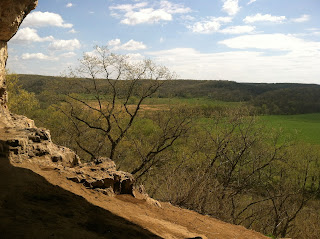While Matt and I awaited the arrival of our new lawnmower in the mail - via the UPS man - we decided that yard-work would have to be put off for a few days. So, in lieu of staying in our own backyard, we decided to explore a bit this weekend.
Accompanying us on our travels through the Missouri countryside was our trusty new dog, Sabrina, who was excited to get out into the woods and sniff away at the fresh air and underbrush of the hills - where I'm sure she smelled some feral hogs, as they are known to roam the eastern boundaries of Ft. Leonard Wood.
We decided to make our way to Miller Cave, one of five major cave systems in the Ft. Leonard Wood cantonment area. A prehistoric site, the Miller Cave complex has provided archaeological evidence that shows the site being used as "a permanent base camp, burial ground and loci for Native American tribes in the region between 7000 B.C. and 1400 A.D."
Nestled 150 feet above the Big Piney River in a sheer cliff-face, overlooking the Big Piney River Valley, the Miller Cave Complex is not only an important archaeological site, but a geological gemstone as well.
Geographically speaking, Miller Cave is located in the Salem Plateau (northern Ozark Highland) of the Missouri Ozarks. The geological components of the rock and earth in the region showcase ordovician-age dolomites and sandstones - remnants of an ancient sea which once covered this area. Through the course of millions of years (the plaque specifically said "200 million") ground water has "uplifted, incised and dissolved [these rocks]....forming steep-sided bluffs and numerous caves and rock shelters." Through this process it has left the countryside marked with caves, springs and underground caverns that are truly wonders to behold.
However, aside from its beauty, there is a sense of reverence one has when walking through the complex. If the walls of such a place could talk, they would undoubtedly speak of music, laughter, love, sorrow, life and death. The cave has seen men come and go through the millennia, and while those men altered their ways of life in the world outside, they never changed the cave which provided them a haven, leaving behind their history for us to remember.
References:
Miller Cave - FLW
Plaques on premise
























